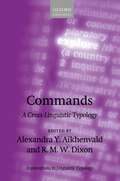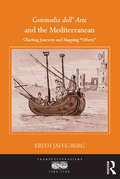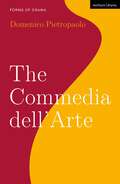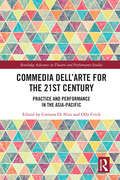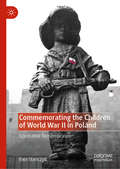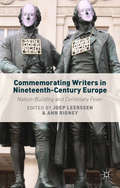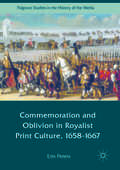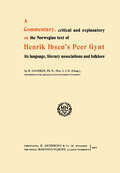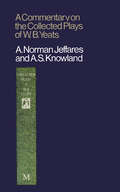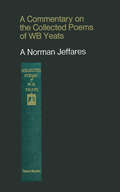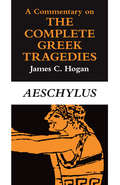- Table View
- List View
Coming To Terms: A Theory of Writing Assessment
by Patricia LynneIn a provocative book-length essay, Patricia Lynne argues that most programmatic assessment of student writing in U.S. public and higher education is conceived in the terms of mid-20th century positivism. Since composition as a field had found its most compatible home in constructivism, she asks, why do compositionists import a conceptual frame for assessment that is incompatible with composition theory? By casting this as a clash of paradigms, Lynne is able to highlight the ways in which each theory can and cannot influence the shape of assessment within composition. She laments, as do many in composition, that the objectively oriented paradigm of educational assessment theory subjugates and discounts the very social constructionist principles that empower composition pedagogy. Further, Lynne criticizes recent practice for accommodating the big business of educational testing—especially for capitulating to the discourse of positivism embedded in terms like "validity" and "reliability." These terms and concepts, she argues, have little theoretical significance within composition studies, and their technical and philosophical import are downplayed by composition assessment scholars. There is a need, Lynne says, for terms of assessment that are native to composition. To open this needed discussion within the field, she analyzes cutting-edge assessment efforts, including the work of Broad and Haswell, and she advances a set of alternate terms for evaluating assessment practices, a set of terms grounded in constructivism and composition. Coming to Terms is ambitious and principled, and it takes a controversial stand on important issues. This strong new volume in assessment theory will be of serious interest to assessment specialists and their students, to composition theorists, and to those now mounting assessments in their own programs.
Commands: A Cross-Linguistic Typology (Explorations in Linguistic Typology)
This book focuses on the form and the function of commands—directive speech acts such as pleas, entreaties, and orders—from a typological perspective. A team of internationally-renowned experts in the field examine the interrelationship of these speech acts with cultural stereotypes and practices, as well as their origins and development, especially in the light of language contact. The volume begins with an introduction outlining the marking and the meaning of imperatives and other ways of expressing commands and directives. Each of the chapters that follow offers an in-depth analysis of commands in a particular language. These analyses are cast in terms of 'basic linguistic theory'—a cumulative typological functional framework—and the chapters are arranged and structured in a way that allows useful comparison between them. The languages investigated include Quechua, Japanese, Lao, Aguaruna and Ashaninka Satipo (both from Peru), Dyirbal (from Australia), Zenzontepec Chatino (from Mexico), Nungon, Tayatuk, and Karawari (from Papua New Guinea), Korowai (from West Papua), Wolaitta (from Ethiopia), and Northern Paiute (a native language of the United States).
Commedia dell' Arte and the Mediterranean: Charting Journeys and Mapping 'Others' (Transculturalisms, 1400-1700)
by Erith Jaffe-BergDrawing on published collections and also manuscripts from Mantuan archives, Commedia dell' arte and the Mediterranean locates commedia dell' arte as a performance form reflective of its cultural crucible in the Mediterranean. The study provides a broad perspective on commedia dell’ arte as an expression of the various cultural, gender and language communities in Italy during the early-modern period, and explores the ways in which the art form offers a platform for reflection on power and cultural exchange. While highlighting the prevalence of Mediterranean crossings in the scenarios of commedia dell' arte, this book examines the way in which actors embodied characters from across the wider Mediterranean region. The presence of Mediterranean minority groups such as Arabs, Armenians, Jews and Turks within commedia dell' arte is marked on stage and 'backstage' where they were collaborators in the creative process. In addition, gendered performances by the first female actors participated in 'staging' the Mediterranean by using the female body as a canvas for cartographical imaginings. By focusing attention on the various communities involved in the making of theatre, a central preoccupation of the book is to question the dynamics of 'exchange' as it materialized within a spectrum inclusive of both cultural collaboration but also of taxation and coercion.
Commedia dell' Arte and the Mediterranean: Charting Journeys and Mapping 'Others' (Transculturalisms, 1400-1700)
by Erith Jaffe-BergDrawing on published collections and also manuscripts from Mantuan archives, Commedia dell' arte and the Mediterranean locates commedia dell' arte as a performance form reflective of its cultural crucible in the Mediterranean. The study provides a broad perspective on commedia dell’ arte as an expression of the various cultural, gender and language communities in Italy during the early-modern period, and explores the ways in which the art form offers a platform for reflection on power and cultural exchange. While highlighting the prevalence of Mediterranean crossings in the scenarios of commedia dell' arte, this book examines the way in which actors embodied characters from across the wider Mediterranean region. The presence of Mediterranean minority groups such as Arabs, Armenians, Jews and Turks within commedia dell' arte is marked on stage and 'backstage' where they were collaborators in the creative process. In addition, gendered performances by the first female actors participated in 'staging' the Mediterranean by using the female body as a canvas for cartographical imaginings. By focusing attention on the various communities involved in the making of theatre, a central preoccupation of the book is to question the dynamics of 'exchange' as it materialized within a spectrum inclusive of both cultural collaboration but also of taxation and coercion.
The Commedia dell’Arte (Forms of Drama)
by Domenico PietropaoloWhat were the origins of commedia dell'arte and how did it evolve as a dramatic form over time and as it spread from Italy? How did its relationship to the ruling ideology of the day change during the Enlightenment? What is its legacy today? These are just some of the questions addressed in this authoritative overview of the dramatic, ideological and aesthetic form of commedia dell'arte. The book's 3 sections examine the changing role of performers and playwrights, improvisatory scenarios and scripted performance, and its function as a vehicle for social criticism, to offer readers a clear understanding of commedia dell'arte's evolution in Renaissance Italy and beyond. This study throws new light on the role of women performers; on the changing ideological discourse of commedia dell'arte, which included social reform and, later, conservatism as well as the alienation of ethnic minorities in complicity with its audience; and on its later adaptation into hybrid forms including grotesque dance and the giullarata typified by the work of Dario Fo.
The Commedia dell’Arte (Forms of Drama)
by Domenico PietropaoloWhat were the origins of commedia dell'arte and how did it evolve as a dramatic form over time and as it spread from Italy? How did its relationship to the ruling ideology of the day change during the Enlightenment? What is its legacy today? These are just some of the questions addressed in this authoritative overview of the dramatic, ideological and aesthetic form of commedia dell'arte. The book's 3 sections examine the changing role of performers and playwrights, improvisatory scenarios and scripted performance, and its function as a vehicle for social criticism, to offer readers a clear understanding of commedia dell'arte's evolution in Renaissance Italy and beyond. This study throws new light on the role of women performers; on the changing ideological discourse of commedia dell'arte, which included social reform and, later, conservatism as well as the alienation of ethnic minorities in complicity with its audience; and on its later adaptation into hybrid forms including grotesque dance and the giullarata typified by the work of Dario Fo.
Commedia dell’Arte for the 21st Century: Practice and Performance in the Asia-Pacific (Routledge Advances in Theatre & Performance Studies)
by Corinna Di Niro Olly CrickThis book discusses the evolution of Commedia dell’Arte in the Asia-Pacific where through the process of reinvention and recreation it has emerged as a variety of hybrids and praxes, all in some ways faithful to the recreated European genre. The contributors in this collection chart their own training in the field and document their strategies for engaging with this form of theatre. In doing so, this book examines the current thoughts, ideas, and perceptions of Commedia – a long-standing theatre genre, originating in a European-based collision between neo-classical drama and oral tradition. The contributing artists, directors, teachers, scholars and theatre-makers give insight into working styles, performance ideas, craft techniques and ways to engage an audience for whom Commedia is not part of their day-to-day culture. The volume presents case studies by current practitioners, some who have trained under known Commedia ‘masters’ (e.g. Lecoq, Boso, Mazzone-Clementi and Fava) and have returned to their country of origin where they have developed their performance and teaching praxis, and others (e.g. travelling from Europe to Japan, Thailand, Singapore and China) who have discovered access points to share or teach Commedia in places where it was previously not known. This book will be of great interest to students and scholars in Performing arts, Italian studies, and History as well as practitioners in Commedia dell’Arte.
Commedia dell’Arte for the 21st Century: Practice and Performance in the Asia-Pacific (Routledge Advances in Theatre & Performance Studies)
by Corinna Di Niro Olly CrickThis book discusses the evolution of Commedia dell’Arte in the Asia-Pacific where through the process of reinvention and recreation it has emerged as a variety of hybrids and praxes, all in some ways faithful to the recreated European genre. The contributors in this collection chart their own training in the field and document their strategies for engaging with this form of theatre. In doing so, this book examines the current thoughts, ideas, and perceptions of Commedia – a long-standing theatre genre, originating in a European-based collision between neo-classical drama and oral tradition. The contributing artists, directors, teachers, scholars and theatre-makers give insight into working styles, performance ideas, craft techniques and ways to engage an audience for whom Commedia is not part of their day-to-day culture. The volume presents case studies by current practitioners, some who have trained under known Commedia ‘masters’ (e.g. Lecoq, Boso, Mazzone-Clementi and Fava) and have returned to their country of origin where they have developed their performance and teaching praxis, and others (e.g. travelling from Europe to Japan, Thailand, Singapore and China) who have discovered access points to share or teach Commedia in places where it was previously not known. This book will be of great interest to students and scholars in Performing arts, Italian studies, and History as well as practitioners in Commedia dell’Arte.
Commemorating the Children of World War II in Poland: Combative Remembrance
by Ewa StańczykThis book explores contemporary debates surrounding Poland’s 'war children', that is the young victims, participants and survivors of the Second World War. It focuses on the period after 2001, which saw the emergence of the two main political parties that were to dictate the tone of the politics of memory for more than a decade. The book shows that 2001 marked a caesura in Poland’s post-Communist history, as this was when the past took center stage in Polish political life. It argues that during this period a distinct culture of commemoration emerged in Poland – one that was not only governed by what the electorate wanted to hear and see, but also fueled by emotions.
Commemorating Writers in Nineteenth-Century Europe: Nation-Building and Centenary Fever
by Joep Leerssen Ann RigneyThis volume offers detailed accounts of the cults of individual writers and a comparative perspective on the spread of centenary fever across Europe. It offers a fascinating insight into the interaction between literature and cultural memory, and the entanglement between local, national and European identities at the highpoint of nation-building.
Commemoration and Oblivion in Royalist Print Culture, 1658-1667
by Erin PetersThis book explores the measures taken by the newly re-installed monarchy and its supporters to address the drastic events of the previous two decades. Profoundly preoccupied with - and, indeed, anxious about - the uses and representations of the nation’s recent troubled past, the returning royalist regime heavily relied upon the dissemination, in popular print, of prescribed varieties of remembering and forgetting in order to actively shape the manner in which the Civil Wars, the Regicide, and the Interregnum were to be embedded in the nation’s collective memory. This study rests on a broad foundation of documentary evidence drawn from hundreds of widely distributed and affordable pamphlets and broadsheets that were intended to shape popular memories, and interpretations, of recent events. It thus makes a substantial original contribution to the fields of early modern memory studies and the history of the English Civil Wars and early Restoration.
Commemoration and Oblivion in Royalist Print Culture, 1658-1667 (PDF)
by Erin PetersThis book explores the measures taken by the newly re-installed monarchy and its supporters to address the drastic events of the previous two decades. Profoundly preoccupied with - and, indeed, anxious about - the uses and representations of the nation’s recent troubled past, the returning royalist regime heavily relied upon the dissemination, in popular print, of prescribed varieties of remembering and forgetting in order to actively shape the manner in which the Civil Wars, the Regicide, and the Interregnum were to be embedded in the nation’s collective memory. This study rests on a broad foundation of documentary evidence drawn from hundreds of widely distributed and affordable pamphlets and broadsheets that were intended to shape popular memories, and interpretations, of recent events. It thus makes a substantial original contribution to the fields of early modern memory studies and the history of the English Civil Wars and early Restoration.
Commemoration as Conflict: Space, Memory and Identity in Peace Processes (Rethinking Peace and Conflict Studies)
by S. McDowell M. BraniffMcDowell and Braniff explore the relationship between commemoration and conflict in societies which have engaged in peace processes, attempting to unpack the ways in which the practices of memory and commemoration influence efforts to bring armed conflict to an end and whether it can even reactivate conflict as political circumstances change.
Commemorative Literacies and Labors of Justice: Resistance, Reconciliation, and Recovery in Buenos Aires and Beyond
by James S. Damico Loren D. Lybarger Edward BrudneyThis book examines literacy practices of commemoration marking the 40th anniversary of the March 24, 1976 coup in Argentina. Drawing on research conducted across three distinct sites in Buenos Aires in March 2016—a public university, a Catholic church, and a former naval base and clandestine detention center transformed into a museum space for memory and justice—this book sheds light on the ways commemorative literacies at these locations work spatially to mobilize memory of the past to address and advance justice concerns in the present. These labors of justice manifest in three ways: as resistance, reconciliation, and recovery. Damico, Lybarger, and Brudney also demonstrate how these particular kinds of commemorative literacies resonate transnationally in ways that necessitate a commitment to commemorative ethics. This book is ideal not only for researchers, graduate students, and scholars in literacy studies but also for all those working in related fields, including memory studies, religious studies, area studies, and Latin American studies, to address issues pertaining to memory, testimony, transitional justice, state repression, and human rights in Argentina, Latin America, or the Global South, more generally.
Commemorative Literacies and Labors of Justice: Resistance, Reconciliation, and Recovery in Buenos Aires and Beyond
by James S. Damico Loren D. Lybarger Edward BrudneyThis book examines literacy practices of commemoration marking the 40th anniversary of the March 24, 1976 coup in Argentina. Drawing on research conducted across three distinct sites in Buenos Aires in March 2016—a public university, a Catholic church, and a former naval base and clandestine detention center transformed into a museum space for memory and justice—this book sheds light on the ways commemorative literacies at these locations work spatially to mobilize memory of the past to address and advance justice concerns in the present. These labors of justice manifest in three ways: as resistance, reconciliation, and recovery. Damico, Lybarger, and Brudney also demonstrate how these particular kinds of commemorative literacies resonate transnationally in ways that necessitate a commitment to commemorative ethics. This book is ideal not only for researchers, graduate students, and scholars in literacy studies but also for all those working in related fields, including memory studies, religious studies, area studies, and Latin American studies, to address issues pertaining to memory, testimony, transitional justice, state repression, and human rights in Argentina, Latin America, or the Global South, more generally.
A Commentary, critical and explanatory on the Norwegian text of Henrik Ibsen’s Peer Gynt its language, literary associations and folklore
by H. LogemanA Commentary on Demosthenes' Philippic I: With Rhetorical Analyses of Philippics II and III (Society for Classical Studies Texts & Commentaries)
by Cecil WootenPhilippic I, delivered between 351 B.C. - 350 B.C., was the first speech by a prominent politician against the growing power of Philip II of Macedon. Along with the other Philippics of Demosthenes', it is arguably one of the finest deliberative speeches from antiquity. The present volume provides the first commentary in English on the Philippics since 1907 and promises to encourage more study of this essential Greek orator. Aiming his commentary at advanced undergraduates and first-year graduate students, Cecil Wooten addresses rhetorical and stylistic matters, historical background, and grammatical problems. In addition to a full commentary on Philippic I, this volume includes essays that outline Philippics II and III, set them in their historical context, and emphasize the differences between these later speeches and the first.
A Commentary on Demosthenes' Philippic I: With Rhetorical Analyses of Philippics II and III (Society for Classical Studies Texts & Commentaries)
by Cecil WootenPhilippic I, delivered between 351 B.C. - 350 B.C., was the first speech by a prominent politician against the growing power of Philip II of Macedon. Along with the other Philippics of Demosthenes', it is arguably one of the finest deliberative speeches from antiquity. The present volume provides the first commentary in English on the Philippics since 1907 and promises to encourage more study of this essential Greek orator. Aiming his commentary at advanced undergraduates and first-year graduate students, Cecil Wooten addresses rhetorical and stylistic matters, historical background, and grammatical problems. In addition to a full commentary on Philippic I, this volume includes essays that outline Philippics II and III, set them in their historical context, and emphasize the differences between these later speeches and the first.
A Commentary on Plutarch's Pericles
by Philip A. StadterPlutarch's Life of Pericles is one of the outstanding works of ancient biography. Called by some a coward and others a boor, Pericles was a genius as a statesman. He ruled Athens like a monarch between 441 and 430 B.C., a period of great political and intellectual achievement. In the first comprehensive commentary in this century on Plutarch's text, Philip Stadter explores both the literary and historical aspects of this extraordinary work, which is included here in Greek in its entirety.In an extensive introduction, Stadter considers the broad questions of the biography's structure, its place and importance within Plutarch's body of literary works, and its relation to its companion piece, the Fabius Maximus. He discussed Plutarch's historical method and argues that the biographer's innovative and thorough use of sources, especially contemporary histories, make Pericles particularly valuable to modern scholars.Examining the literary devices that shape and organize the work, Stadter analyzes the Greek text line by line. A detailed study of word usage and meaning complements grammatical and lexicographical notes that make the peculiarities of Plutarch's Greek accessible to readers unfamiliar with the original text.This evaluation of Plutarch's biographical technique is exceptional in its combination of archaeological, epigraphical, and historical analysis. Pericles emerges from the discussion as a masterpiece of later Greek prose and biography. Stadter's thorough and insightful analysis secures the importance of this text as both a work of literature and a vivid depiction of the society, culture, and politics of fifth-century Athens.Originally published in 1989.A UNC Press Enduring Edition -- UNC Press Enduring Editions use the latest in digital technology to make available again books from our distinguished backlist that were previously out of print. These editions are published unaltered from the original, and are presented in affordable paperback formats, bringing readers both historical and cultural value.
A Commentary on The Complete Greek Tragedies. Aeschylus: Aeschylus
by James C. HoganThis commentary offers a rich introduction and useful guide to the seven surviving plays attributed to Aeschylus. Though it may profitably be used with any translation of Aeschylus, the commentary is based on the acclaimed Chicago translations, The Complete Greek Tragedies, edited by David Grene and Richmond Lattimore. James C. Hogan provides a general introduction to Aeschylean theater and drama, followed by a line-by-line commentary on each of the seven plays. He places Aeschylus in the historical, cultural, and religious context of fifth-century Athens, showing how the action and metaphor of Aeschylean theater can be illuminated by information on Athenian law athletic contests, relations with neighboring states, beliefs about the underworld, and countless other details of Hellenic life. Hogan clarifies terms that might puzzle modern readers, such as place names and mythological references, and gives special attention to textual and linguistic issues: controversial questions of interpretation; difficult or significant Greek words; use of style, rhetoric, and commonplaces in Greek poetry; and Aeschylus's place in the poetic tradition of Homer, Hesiod, and the elegiac poets. Practical information on staging and production is also included, as are maps and illustrations, a bibliography, indexes, and extensive cross-references between the seven plays. Forthcoming volumes will cover the works of Sophocles and Euripides.
A Commentary on The Complete Greek Tragedies. Aeschylus: Aeschylus
by James C. HoganThis commentary offers a rich introduction and useful guide to the seven surviving plays attributed to Aeschylus. Though it may profitably be used with any translation of Aeschylus, the commentary is based on the acclaimed Chicago translations, The Complete Greek Tragedies, edited by David Grene and Richmond Lattimore. James C. Hogan provides a general introduction to Aeschylean theater and drama, followed by a line-by-line commentary on each of the seven plays. He places Aeschylus in the historical, cultural, and religious context of fifth-century Athens, showing how the action and metaphor of Aeschylean theater can be illuminated by information on Athenian law athletic contests, relations with neighboring states, beliefs about the underworld, and countless other details of Hellenic life. Hogan clarifies terms that might puzzle modern readers, such as place names and mythological references, and gives special attention to textual and linguistic issues: controversial questions of interpretation; difficult or significant Greek words; use of style, rhetoric, and commonplaces in Greek poetry; and Aeschylus's place in the poetic tradition of Homer, Hesiod, and the elegiac poets. Practical information on staging and production is also included, as are maps and illustrations, a bibliography, indexes, and extensive cross-references between the seven plays. Forthcoming volumes will cover the works of Sophocles and Euripides.
A Commentary on The Complete Greek Tragedies. Aeschylus: Aeschylus
by James C. HoganThis commentary offers a rich introduction and useful guide to the seven surviving plays attributed to Aeschylus. Though it may profitably be used with any translation of Aeschylus, the commentary is based on the acclaimed Chicago translations, The Complete Greek Tragedies, edited by David Grene and Richmond Lattimore. James C. Hogan provides a general introduction to Aeschylean theater and drama, followed by a line-by-line commentary on each of the seven plays. He places Aeschylus in the historical, cultural, and religious context of fifth-century Athens, showing how the action and metaphor of Aeschylean theater can be illuminated by information on Athenian law athletic contests, relations with neighboring states, beliefs about the underworld, and countless other details of Hellenic life. Hogan clarifies terms that might puzzle modern readers, such as place names and mythological references, and gives special attention to textual and linguistic issues: controversial questions of interpretation; difficult or significant Greek words; use of style, rhetoric, and commonplaces in Greek poetry; and Aeschylus's place in the poetic tradition of Homer, Hesiod, and the elegiac poets. Practical information on staging and production is also included, as are maps and illustrations, a bibliography, indexes, and extensive cross-references between the seven plays. Forthcoming volumes will cover the works of Sophocles and Euripides.
A Commentary on The Complete Greek Tragedies. Aeschylus: Aeschylus
by James C. HoganThis commentary offers a rich introduction and useful guide to the seven surviving plays attributed to Aeschylus. Though it may profitably be used with any translation of Aeschylus, the commentary is based on the acclaimed Chicago translations, The Complete Greek Tragedies, edited by David Grene and Richmond Lattimore. James C. Hogan provides a general introduction to Aeschylean theater and drama, followed by a line-by-line commentary on each of the seven plays. He places Aeschylus in the historical, cultural, and religious context of fifth-century Athens, showing how the action and metaphor of Aeschylean theater can be illuminated by information on Athenian law athletic contests, relations with neighboring states, beliefs about the underworld, and countless other details of Hellenic life. Hogan clarifies terms that might puzzle modern readers, such as place names and mythological references, and gives special attention to textual and linguistic issues: controversial questions of interpretation; difficult or significant Greek words; use of style, rhetoric, and commonplaces in Greek poetry; and Aeschylus's place in the poetic tradition of Homer, Hesiod, and the elegiac poets. Practical information on staging and production is also included, as are maps and illustrations, a bibliography, indexes, and extensive cross-references between the seven plays. Forthcoming volumes will cover the works of Sophocles and Euripides.

